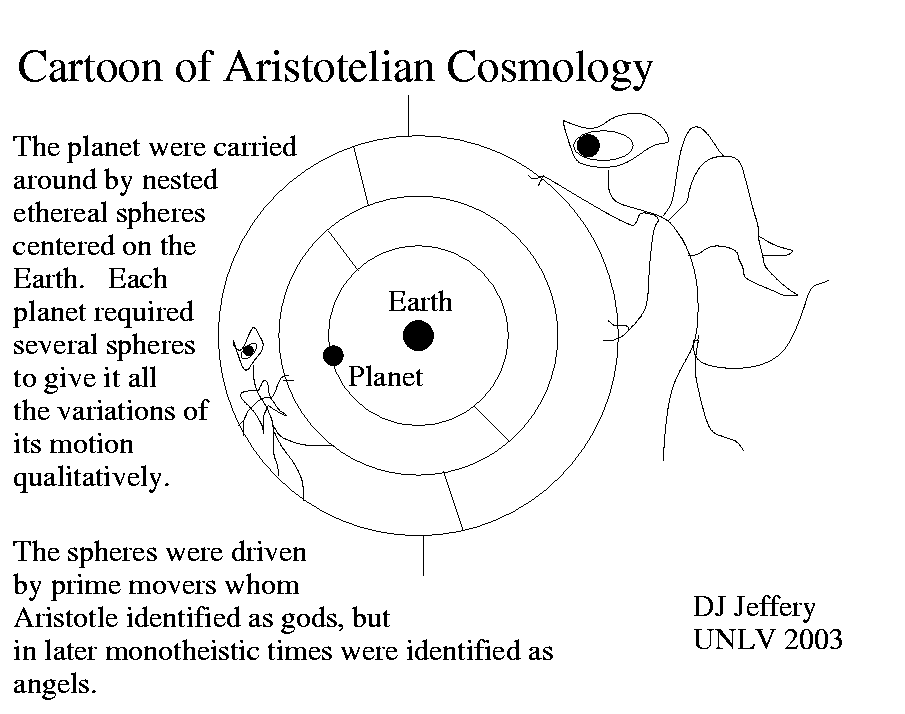
Caption: A summary of Aristotelian cosmology:
- Geocentric like almost all cosmological models in ancient Greek astronomy.
- A spherical Earth at rest in an absolute sense at the center of the universe.
- The astronomical objects are carried around the Earth by NESTED celestial spheres connected by offset axes on which the celestial spheres rotate with uniform angular velocities which means they execute uniform circular motions. The celestial spheres are actually adopted from the Eudoxon planetary model theorized by Eudoxus of Cnidus (410 or 408--355 or 347 BCE).
- The outermost of the celestial spheres is the celestial sphere of the stars on which the stars are pasted and which is the ancestor of the modern celestial sphere. The celestial sphere of the stars exhibits a diurnal rotation westward.
- Beyond the celestial sphere of the stars is nothing, NOT even empty space.
- There 47 celestial spheres or 55 celestial spheres. Aristotle was NOT clear on this point.
- The motions of the celestial spheres can be adjusted to fit the observations QUALITATIVELY, but NOT QUANTITATIVELY and maybe no one ever tried. You CANNOT calculate ephemerides from Aristotelian cosmology. Even QUALITATIVELY, the fit is probably NOT very good.???
- The celestial spheres were made of the aether (AKA quintessence or 5th element) which was one of the 5 classical elements (earth, water, air, fire, aether), but was only found in the Heavens and never below the Moon (i.e., in the sublunary sphere).
- The Heavens were unchanging (i.e., eternal) and perfect because they were unchanging it seems. The sublunary sphere was changing and so imperfect.
- The celestial spheres were moved by prime movers (AKA unmoved movers) who were gods, but NOT ones to be worshipped. They were as conscious beings---ones who think only thinking itself (see Wikipedia: Unmoved mover: Aristotle's theology). In monotheistic times, the prime movers were interpreted as being angels.
- Aristotelian cosmology did NOT have epicycles unlike Ptolemaic system. Pure Aristotelians always rejected epicycles as physically unreal though useful as calculating devices. Ptolemy (c.100--c.170 CE) himself was an impure Aristotelian since he believed epicycles were real or could be real as evidenced by his book Planetary Hypotheses (c.150).
- Actually, even the ancient Greek astronomers and other ancient astronomers were aware that the Moon's angular diameter varied by ∼11 % (note: Moon angular diameter: mean 0.5286°, range 0.4889°--0.5683°). This meant that the Earth-Moon distance (note: Moon mean orbital radius R_Mo = 384,748 km = 60.3229 R_eq_⊕ ≅ 60 R_eq_⊕) varies by ∼11 %. This violated Aristotelian cosmology where the distances to the classical planets (in assumed outward going order from the Earth ⊕ they are Moon ☽, Mercury ☿, Venus ♀, Sun ☉, Mars ♂, Jupiter ♃, Saturn ♄) were absolutely invariant. Pure Aristotelians ignored this point or just said Aristotelian cosmology was NOT perfect, but was the best human reason could do.
- The varying Earth-Moon distance should have been a strong point for epicycle models since they give varying distances to all the classical planets. However, in the Ptolemaic system the Earth-Moon distance varies by ∼ 50 % in clear violation even casual observations????. Ptolemy (c.100--c.170 CE) did NOT even bother to comment on this clue to reality. Later astronomers working with epicycle models probably tried to fix the discrepancy, but yours truly does NOT know how well they succeeded.
Credit/Permission: ©
David Jeffery,
2003 / Own work.
Image link: Itself.
Local file: local link: aristotle_cosmology_summarized.html.
File: Aristotle file:
aristotle_cosmology_summarized.html.